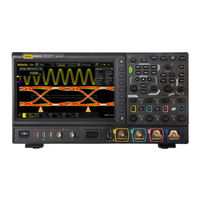Rigol MSO8074A Manuals
Manuals and User Guides for Rigol MSO8074A. We have 3 Rigol MSO8074A manuals available for free PDF download: User Manual, Manual, Quick Manual
Rigol MSO8074A User Manual (406 pages)
Digital Oscilloscope
Brand: Rigol
|
Category: Test Equipment
|
Size: 11 MB
Table of Contents
-
Quick Start28
-
Vertical41
-
Horizontal42
-
Wave44
-
Trigger45
-
Clear45
-
Auto45
-
Run/Stop46
-
Single46
-
Tap53
-
Drag54
-
BW Limit68
-
Probe Ratio68
-
Active Probe72
-
YT Mode81
-
XY Mode81
-
ROLL Mode84
-
Normal84
-
Average85
-
Peak86
-
Sample Rate87
-
Memory Depth88
-
Trigger Mode94
-
Trigger Type97
-
Edge Trigger98
-
Slope Trigger101
-
Video Trigger105
-
Pattern Trigger107
-
Duration Trigger110
-
Timeout Trigger113
-
Runt Trigger115
-
Window Trigger117
-
Delay Trigger119
-
Nth Edge Trigger124
-
Zone Trigger149
-
Math Operation153
-
Addition154
-
Subtraction155
-
Multiplication156
-
Division157
-
Fft159
-
AND" Operation163
-
OR" Operation165
-
XOR" Operation167
-
NOT" Operation168
-
Intg170
-
Diff171
-
Sqrt172
-
Exp176
-
Abs177
-
Low Pass178
-
High Pass179
-
Band Pass181
-
Band Stop182
-
Ax+B183
-
Avg185
-
Auto Measurement187
-
All Measurement202
-
Manual Mode204
-
Track Mode209
-
XY Mode212
-
Measure Mode214
-
To Clear Count218
-
Power Quality220
-
Ripple223
-
To Reset228
-
To Reset Color233
-
Jitter Analysis233
-
Digital Channel239
-
To Set the Label242
-
Group Setting242
-
To Set the Label298
-
Pass/Fail Test300
-
To Create a Mask301
-
To Save a Mask302
-
To Load a Mask302
-
Common Settings305
-
Record Options306
-
Play Options308
-
Search Function309
-
Display Control313
-
Show Scale315
-
Color Grade315
-
Waveform Freeze315
-
To Output Sine317
-
To Output Square319
-
To Output Ramp319
-
To Output Pulse320
-
To Output DC320
-
To Output Noise321
-
Sinc321
-
Exp.rise322
-
Figure 21.3 Sinc322
-
Exp.fall323
-
Ecg323
-
Gauss324
-
Figure 21.6 ECG324
-
Lorentz325
-
Haversine326
-
Modulation332
-
Figure 21.10 am332
-
Figure 21.11 FM333
-
Fsk334
-
Sweep335
-
Burst337
-
Store and Load339
-
Storage System339
-
Storage Type339
-
Load Type345
-
Disk Management348
-
Factory Settings355
-
To Set Mdns378
-
To Set HDMI378
-
USB Connection379
-
System-Related379
-
Beeper379
-
Language379
-
Power on380
-
Power Status380
-
Aux Output380
-
Ref Clock381
-
Help Menu381
-
Selfcal382
-
Auto Config383
-
Print Setting383
-
Email385
-
Key Locker386
-
Quick Operation387
-
Screen Saver390
-
Self-Check391
-
System Time392
-
Default Option393
-
Remote Control395
-
Troubleshooting399
-
Appendix401
-
Index403
Advertisement
Rigol MSO8074A Manual (405 pages)
Digital Oscilloscope
Brand: Rigol
|
Category: Test Equipment
|
Size: 12 MB
Table of Contents
-
-
-
BW Limit68
-
Probe Ratio68
-
-
Sample Rate87
-
Memory Depth88
-
-
Trigger Mode94
-
Trigger Type97
-
Edge Trigger98
-
Slope Trigger101
-
Video Trigger105
-
Pattern Trigger107
-
Duration Trigger110
-
Timeout Trigger113
-
Runt Trigger115
-
Window Trigger117
-
Delay Trigger119
-
Nth Edge Trigger124
-
Zone Trigger149
-
-
Math Operation153
-
Addition154
-
Subtraction155
-
Multiplication156
-
Division157
-
Fft159
-
AND" Operation163
-
OR" Operation165
-
XOR" Operation167
-
NOT" Operation168
-
Intg170
-
Diff171
-
Sqrt172
-
Exp176
-
Abs177
-
Low Pass178
-
High Pass179
-
Band Pass181
-
Band Stop182
-
Ax+B183
-
Avg185
-
-
Auto Measurement187
-
-
All Measurement202
-
Manual Mode204
-
Track Mode209
-
XY Mode212
-
Measure Mode214
-
-
-
-
-
Jitter Analysis233
-
-
-
To Set the Label297
-
-
To Create a Mask300
-
To Save a Mask301
-
To Load a Mask301
-
-
Common Settings304
-
Record Options305
-
Play Options307
-
-
-
Search Function308
-
-
-
-
To Output Sine316
-
To Output Square318
-
To Output Ramp318
-
To Output Pulse319
-
To Output DC319
-
To Output Noise320
-
Sinc320
-
Exp.rise321
-
Figure 21.3 Sinc321
-
Exp.fall322
-
Ecg322
-
Gauss323
-
Figure 21.6 ECG323
-
Lorentz324
-
Haversine325
-
-
Modulation331
-
Figure 21.10 am331
-
Figure 21.11 FM332
-
Fsk333
-
-
Sweep334
-
Burst336
-
-
-
Storage System338
-
Storage Type338
-
Load Type344
-
Disk Management347
-
Factory Settings354
-
-
-
System-Related378
-
Beeper378
-
Language378
-
Power on379
-
Power Status379
-
Aux Output379
-
Ref Clock380
-
Help Menu380
-
Selfcal381
-
Auto Config382
-
Print Setting382
-
Email384
-
Key Locker385
-
Quick Operation386
-
Screen Saver389
-
Self-Check390
-
System Time391
-
Default Option392
-
-
26 Appendix
400
Rigol MSO8074A Quick Manual (31 pages)
Digital Oscilloscope
Brand: Rigol
|
Category: Test Equipment
|
Size: 5 MB
Table of Contents
Advertisement
Advertisement


